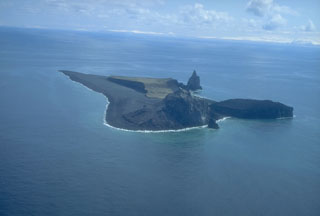Report on Bogoslof (United States) — 14 December-20 December 2016
Smithsonian Institution / US Geological Survey
Weekly Volcanic Activity Report, 14 December-20 December 2016
Managing Editor: Sally Sennert.
Please cite this report as:
Global Volcanism Program, 2016. Report on Bogoslof (United States) (Sennert, S, ed.). Weekly Volcanic Activity Report, 14 December-20 December 2016. Smithsonian Institution and US Geological Survey.
Bogoslof
United States
53.93°N, 168.03°W; summit elev. 150 m
All times are local (unless otherwise noted)
AVO reported that a short-lived explosive eruption at Bogoslof, observed and reported by several pilots around 1600 on 20 December, produced an ash plume that rose to 10.3 km (34,000 ft) a.s.l. A subsequent pilot report made 50 minutes later indicated that activity had decreased. Satellite data showed a discrete, short-lived explosion just prior to 1600, and a detached plume that drifted S. AVO raised the Aviation Color Code to Red and the Volcano Alert Level to Warning.
Geological Summary. Bogoslof is the emergent summit of a submarine volcano that lies 40 km N of the main Aleutian arc. It rises 1,500 m above the Bering Sea floor. Repeated construction and destruction of lava domes at different locations during historical time has greatly modified the appearance of this "Jack-in-the-Box" volcano and has introduced a confusing nomenclature applied during frequent visits by exploring expeditions. The present triangular-shaped, 0.75 x 2 km island consists of remnants of lava domes emplaced from 1796 to 1992. Castle Rock (Old Bogoslof) is a steep-sided pinnacle that is a remnant of a spine from the 1796 eruption. The small Fire Island (New Bogoslof), about 600 m NW of Bogoslof Island, is a remnant of a lava dome formed in 1883.
Source: US Geological Survey Alaska Volcano Observatory (AVO)

